The Smart Home Automation Technology Market is estimated to be valued at USD 80.1 billion in 2025 and is projected to reach USD 227.3 billion by 2035, registering a compound annual growth rate (CAGR) of 11.0% over the forecast period.
From 2025 to 2030, growth will be driven by widespread use of smart lighting, security systems, and voice-enabled assistants, supported by falling device costs and integration with cloud-based ecosystems.
Between 2030 and 2035, the trajectory is expected to accelerate as homes increasingly incorporate advanced energy management, AI-driven predictive controls, and seamless interoperability across appliances, HVAC, and entertainment systems. The incremental opportunity of USD 147.2 billion highlights the scale of transformation within residential infrastructure.
Competitive intensity will deepen as global technology companies, telecom operators, and appliance manufacturers position themselves with differentiated platforms and bundled services. Regional growth is expected to be strongest in North America, Europe, and Asia, with emerging economies also expanding adoption through the use of affordable modular systems.

| Metric | Value |
|---|---|
| Smart Home Automation Technology Market Estimated Value in (2025 E) | USD 80.1 billion |
| Smart Home Automation Technology Market Forecast Value in (2035 F) | USD 227.3 billion |
| Forecast CAGR (2025 to 2035) | 11.0% |
The smart home automation technology market is expanding rapidly due to growing consumer demand for convenience, energy efficiency, and enhanced security in residential spaces. The integration of intelligent systems into household infrastructure has been driven by rising urbanization, increasing smartphone penetration, and widespread availability of high speed internet.
Homeowners are increasingly adopting automation solutions that offer centralized control over lighting, appliances, climate, and security systems. The push toward sustainable living and energy conservation has further strengthened the case for smart technologies, especially those compatible with renewable energy systems and energy monitoring features.
Government initiatives encouraging smart infrastructure and the emergence of voice controlled digital assistants are also propelling market growth. The outlook remains strong as automation becomes a core component of modern living, with ongoing innovation across hardware, software, and connectivity platforms shaping the future of residential environments.
The smart home automation technology market is segmented by technology, application, and geographic regions. By technology of the smart home automation technology market is divided into Wired technology and Wireless technology. In terms of application of the smart home automation technology market is classified into Home security and monitoring, Energy management, Home entertainment, Health and wellness, and Others.
Regionally, the smart home automation technology industry is classified into North America, Latin America, Western Europe, Eastern Europe, Balkan & Baltic Countries, Russia & Belarus, Central Asia, East Asia, South Asia & Pacific, and the Middle East & Africa.
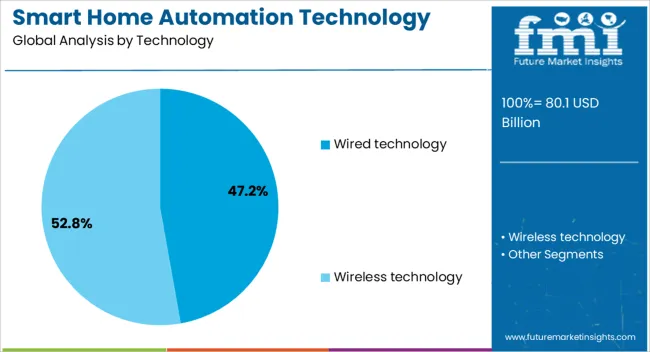
The wired technology segment is projected to contribute 47.20% of total revenue by 2025 within the technology category, positioning it as the leading segment. This dominance is driven by its reliability, stable connectivity, and minimal susceptibility to external interference.
Wired systems are particularly favored in newly constructed homes and large residential complexes where integrated infrastructure can be implemented during the build phase. Their consistent performance in managing high bandwidth applications such as surveillance cameras, multi room audio, and centralized control systems has made them a preferred choice for comprehensive home automation setups.
Additionally, wired systems offer enhanced security compared to wireless alternatives, making them attractive for homeowners concerned with data privacy and system integrity. As long-term durability and uninterrupted performance continue to be prioritized, wired technology maintains a leading position in the smart home automation landscape.
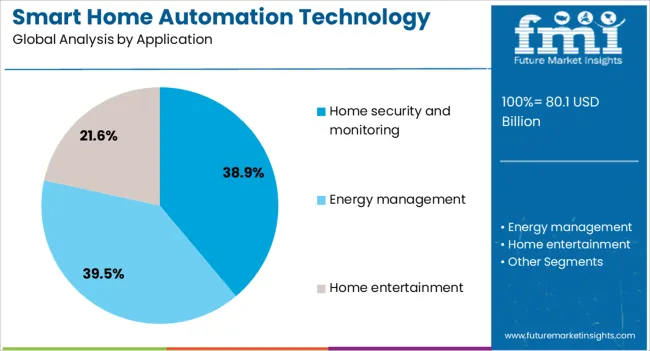
The home security and monitoring segment is expected to account for 38.90% of total market revenue by 2025, making it the most prominent application category. The growing awareness of residential safety risks, rising crime rates in urban areas, and increased availability of cost-effective security solutions have collectively driven this trend.
Homeowners are investing in smart cameras, door sensors, motion detectors, and alarm systems that offer remote access and real time alerts through connected devices. Integration with mobile apps and cloud platforms has enabled seamless monitoring and response, even when residents are away from home.
Moreover, insurance incentives and the psychological assurance provided by smart security systems are encouraging higher adoption. As safety remains a top priority for consumers, the home security and monitoring segment continues to lead the market in terms of application.
The smart home automation market is expanding due to rising consumer demand for convenience, security, and energy efficiency. Technological advancements and affordability are accelerating adoption, particularly in emerging markets.
The smart home automation technology market is driven by rising consumer demand for convenience, security, and energy efficiency. Consumers increasingly seek automation solutions to control lighting, heating, and security systems through mobile apps and voice assistants. The growing preference for connected devices, such as smart speakers and thermostats, is encouraging widespread adoption. Moreover, the increasing availability of affordable smart devices is contributing to market growth. As more individuals realize the benefits of home automation, including energy savings and enhanced security, the demand for such systems continues to rise, particularly in developed regions with higher disposable income.
The integration of IoT and AI technologies is a major dynamic propelling the smart home automation market forward. These technologies enable devices to communicate and learn from user preferences, resulting in more personalized and efficient home automation systems. Smart thermostats, lighting, and security systems can now adjust settings based on individual patterns and behaviors, optimizing performance without manual intervention. This level of automation not only enhances the user experience but also boosts operational efficiency. The growth in connected devices that support voice assistants like Alexa and Google Assistant also plays a crucial role in making home automation more accessible and effective.
Home security remains one of the most critical driving factors behind the growth of smart home automation. The demand for security-focused automation systems, such as smart locks, surveillance cameras, and motion detectors, is rising. These systems offer homeowners the ability to monitor their properties remotely, providing peace of mind and increased safety. The integration of features like facial recognition and real-time alerts enhances the appeal of smart security systems. As concerns about home theft and safety rise, more consumers are investing in smart home solutions to secure their properties, driving the overall market forward, particularly in urban regions.
Emerging markets are playing an increasingly important role in the growth of the smart home automation market. In regions like Asia-Pacific, smart home solutions are being adopted at an accelerated pace as incomes rise and technology becomes more affordable. Manufacturers are introducing budget-friendly smart devices, making home automation accessible to a larger audience. This affordability is expected to expand the market in countries with emerging middle classes, such as China and India. As these markets continue to grow, the demand for smart homes, particularly in the form of energy-efficient and security-focused solutions, will drive further market expansion in the coming years.
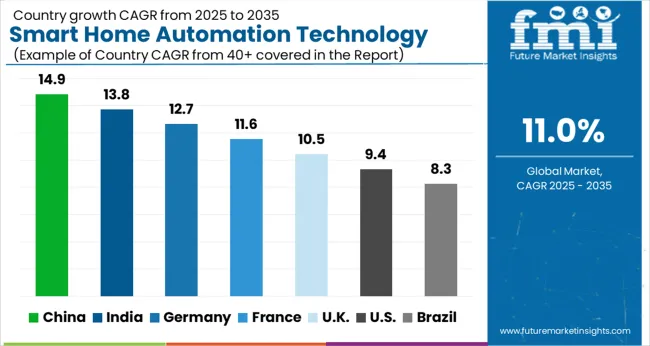
| Countries | CAGR |
|---|---|
| China | 14.9% |
| India | 13.8% |
| Germany | 12.7% |
| France | 11.6% |
| UK | 10.5% |
| USA | 9.4% |
| Brazil | 8.3% |
The smart home automation technology market is witnessing significant growth across multiple regions. China leads with a growth rate of 14.9%, driven by increasing adoption of IoT devices, rising disposable incomes, and government initiatives supporting smart home technology integration. India follows closely with a 13.8% growth rate, fueled by the growing middle class, urbanization, and the expanding availability of affordable smart devices. France is projected to see an 11.6% growth rate, driven by rising demand for security and energy-efficient home technologies. The UK is experiencing a 10.5% growth rate, aided by the rising trend of connected devices and government incentives for smart home adoption. The USA shows a 9.4% growth rate, reflecting stable demand for home automation solutions with a focus on convenience and security in residential homes. These countries are driving the global smart home automation market, each contributing to the growing demand for connected and intelligent home solutions.
The UK is projected to post a CAGR of 10.5% for 2025–2035, higher than the 9.0% recorded during 2020–2024. This uplift is driven by the growing adoption of connected devices, increasing focus on home security, and rising consumer interest in energy-efficient technologies. As smart home solutions become more accessible, with improvements in affordability and user-friendliness, the market in the UK is estimated for accelerated growth. Additionally, government initiatives promoting energy conservation through smart home systems are expected to further enhance market expansion.
China is expected to achieve a CAGR of 14.9% for 2025–2035, up from 13.3% during 2020–2024. The strong growth during both periods is driven by China’s rapid adoption of smart technologies and increasing urbanization. Rising disposable incomes and a greater shift towards tech-savvy living have led to an increased demand for smart home systems. In addition, government support for green technologies and automation plays a key role in driving market expansion. By 2025, as smart homes become more integrated with daily life and work environments, adoption rates are expected to accelerate further.
India is projected to achieve a CAGR of 13.8% for 2025–2035, rising from 12.2% during 2020–2024. The surge in growth is fueled by a growing urban middle class, improved internet connectivity, and the increasing affordability of smart home devices. Government incentives for energy-efficient appliances also contribute to the growth, as do advances in mobile connectivity and voice-activated technologies. The demand for enhanced security, coupled with greater consumer awareness of energy management, will drive India’s continued adoption of home automation solutions.

France is expected to experience a CAGR of 11.6% for 2025–2035, up from 10.4% in the 2020–2024 period. The strong performance during both periods is attributed to France’s ongoing push for eco-friendly and energy-efficient homes. A focus on sustainability, alongside government incentives for smart home technologies, is pushing adoption among homeowners and developers. The integration of voice-activated smart systems and IoT-enabled devices into homes is also contributing to the growth. As the demand for automation in daily life increases, France’s market for smart home systems will continue to rise.
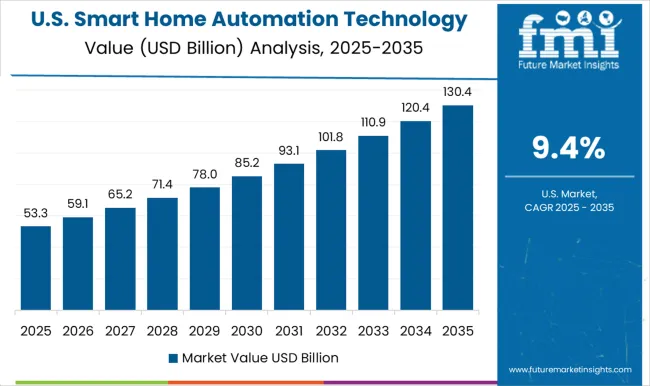
The USA smart home automation market is expected to grow at a CAGR of 9.4% for 2025–2035, down slightly from 9.8% during 2020–2024. This slight slowdown is due to market maturity, with many households already adopting basic smart home technologies. However, demand for more advanced and integrated solutions is increasing, including smart security systems, energy management, and voice-assisted devices. The growing trend of home upgrades, especially in suburban areas, will fuel demand for smart home solutions in the coming decade. Additionally, consumer awareness of energy savings and home security will sustain the market’s growth.
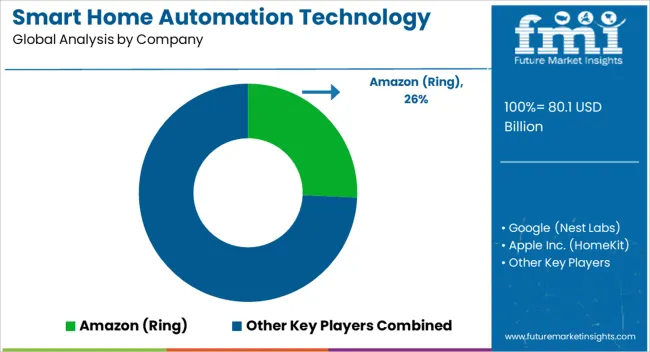
The smart home automation technology market is highly competitive, with several key players offering innovative solutions. Amazon (Ring) has established itself as a leading provider in the home security segment, offering video doorbells, cameras, and smart home integration. Google (Nest Labs), with its Nest product line, leads the market in smart thermostats, security cameras, and smart smoke alarms, offering seamless integration with Google Assistant.
Apple Inc. (HomeKit) has a strong presence through its smart home ecosystem, enabling users to control devices via Siri and the Home app, with a focus on privacy and seamless integration across its devices. Samsung Electronics offers a wide range of smart home devices under the SmartThings brand, providing automation and control across various home devices, including security systems, lighting, and energy management. Koninklijke Philips N.V. leads in the smart lighting segment with its Philips Hue brand, known for its highly customizable smart lighting solutions.
Ecobee Inc. is a key player in smart thermostats, offering energy-efficient products that are highly regarded for their performance and integration with other smart home systems. Honeywell International, Inc. brings energy management and home security solutions with a focus on integrated home control systems. Lutron Electronics Co., Inc. stands out in the lighting and shading systems market, providing advanced control for lighting, window treatments, and home automation integration with various smart home platforms.
| Item | Value |
|---|---|
| Quantitative Units | USD 80.1 Billion |
| Technology | Wired technology and Wireless technology |
| Application | Home security and monitoring, Energy management, Home entertainment, Health and wellness, and Others |
| Regions Covered | North America, Europe, Asia-Pacific, Latin America, Middle East & Africa |
| Country Covered | United States, Canada, Germany, France, United Kingdom, China, Japan, India, Brazil, South Africa |
| Key Companies Profiled | Amazon (Ring), Google (Nest Labs), Apple Inc. (HomeKit), Samsung Electronics, Koninklijke Philips N.V, Ecobee Inc., Honeywell International, Inc., and Lutron Electronics Co., Inc. |
| Additional Attributes | Dollar sales, and growth projections across regions, understanding competitive dynamics, including market share and product offerings of key players, is crucial. |
The global smart home automation technology market is estimated to be valued at USD 80.1 billion in 2025.
The market size for the smart home automation technology market is projected to reach USD 227.3 billion by 2035.
The smart home automation technology market is expected to grow at a 11.0% CAGR between 2025 and 2035.
The key product types in smart home automation technology market are wired technology, _ethernet, _powerline communication (plc), _others, wireless technology, _wi-fi, _bluetooth, _zigbee, _z-wave, _thread and _others.
In terms of application, home security and monitoring segment to command 38.9% share in the smart home automation technology market in 2025.






Our Research Products

The "Full Research Suite" delivers actionable market intel, deep dives on markets or technologies, so clients act faster, cut risk, and unlock growth.

The Leaderboard benchmarks and ranks top vendors, classifying them as Established Leaders, Leading Challengers, or Disruptors & Challengers.

Locates where complements amplify value and substitutes erode it, forecasting net impact by horizon

We deliver granular, decision-grade intel: market sizing, 5-year forecasts, pricing, adoption, usage, revenue, and operational KPIs—plus competitor tracking, regulation, and value chains—across 60 countries broadly.

Spot the shifts before they hit your P&L. We track inflection points, adoption curves, pricing moves, and ecosystem plays to show where demand is heading, why it is changing, and what to do next across high-growth markets and disruptive tech

Real-time reads of user behavior. We track shifting priorities, perceptions of today’s and next-gen services, and provider experience, then pace how fast tech moves from trial to adoption, blending buyer, consumer, and channel inputs with social signals (#WhySwitch, #UX).

Partner with our analyst team to build a custom report designed around your business priorities. From analysing market trends to assessing competitors or crafting bespoke datasets, we tailor insights to your needs.
Supplier Intelligence
Discovery & Profiling
Capacity & Footprint
Performance & Risk
Compliance & Governance
Commercial Readiness
Who Supplies Whom
Scorecards & Shortlists
Playbooks & Docs
Category Intelligence
Definition & Scope
Demand & Use Cases
Cost Drivers
Market Structure
Supply Chain Map
Trade & Policy
Operating Norms
Deliverables
Buyer Intelligence
Account Basics
Spend & Scope
Procurement Model
Vendor Requirements
Terms & Policies
Entry Strategy
Pain Points & Triggers
Outputs
Pricing Analysis
Benchmarks
Trends
Should-Cost
Indexation
Landed Cost
Commercial Terms
Deliverables
Brand Analysis
Positioning & Value Prop
Share & Presence
Customer Evidence
Go-to-Market
Digital & Reputation
Compliance & Trust
KPIs & Gaps
Outputs
Full Research Suite comprises of:
Market outlook & trends analysis
Interviews & case studies
Strategic recommendations
Vendor profiles & capabilities analysis
5-year forecasts
8 regions and 60+ country-level data splits
Market segment data splits
12 months of continuous data updates
DELIVERED AS:
PDF EXCEL ONLINE
Smart Home Automation Market Size and Share Forecast Outlook 2025 to 2035
Smart Home Automation in India – IoT & AI-Driven Growth
Home Automation Sensors Market Size and Share Forecast Outlook 2025 to 2035
Home Automation Market Analysis by Product, Application, Networking Technology, and Region Through 2035
Smart Home Wireless Smoke Detector Market Size and Share Forecast Outlook 2025 to 2035
Smart Home Devices Market Size and Share Forecast Outlook 2025 to 2035
Smart-Technology Anti-Wrinkle Peptides Market Size and Share Forecast Outlook 2025 to 2035
Smart Home Gym Equipment Market Size and Share Forecast Outlook 2025 to 2035
Smart Home Service Market Size and Share Forecast Outlook 2025 to 2035
Smart Home Security Camera Market Analysis - Size, Share, and Forecast 2025 to 2035
Smart Home Market Size and Share Forecast Outlook 2025 to 2035
Smart Home-Based Beverage Machine Market Size and Share Forecast Outlook 2025 to 2035
Smart Home Payments Market Size and Share Forecast Outlook 2025 to 2035
Smart Home Solutions Market Size and Share Forecast Outlook 2025 to 2035
Smart Home Appliances Market Growth – Trends & Forecast 2025 to 2035
Smart Home Water Sensors & Controllers Market Trends & Forecast 2025 to 2035
Smart Home Platforms Market Growth – Trends & Forecast through 2034
Smart Home Hub Market
Smart Grid Home Area Network (HAN) Market Size and Share Forecast Outlook 2025 to 2035
Smart Grid Technology Market Analysis - Growth, Demand & Forecast 2025 to 2035

Thank you!
You will receive an email from our Business Development Manager. Please be sure to check your SPAM/JUNK folder too.
Chat With
MaRIA